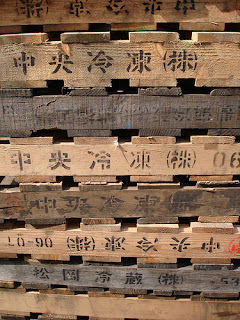 If there’s on place to see over 400 different types of fish and seafood other than in the world’s oceans, it is at the Tsukiji fish market (築地市場, Tsukiji shijō), part of the Tokyo Metropolitan Central Wholesale Market which also handles meat, vegetables and flowers. One of three fish markets in Tokyo trading over 700, 000 metric tonnes of seafood equivalent to 6 billion US dollars in value, Tsukiji is not only the largest fish market in Tokyo serving its 20 million plus residents but also in the world.
If there’s on place to see over 400 different types of fish and seafood other than in the world’s oceans, it is at the Tsukiji fish market (築地市場, Tsukiji shijō), part of the Tokyo Metropolitan Central Wholesale Market which also handles meat, vegetables and flowers. One of three fish markets in Tokyo trading over 700, 000 metric tonnes of seafood equivalent to 6 billion US dollars in value, Tsukiji is not only the largest fish market in Tokyo serving its 20 million plus residents but also in the world.Tsukiji handles about 2000 metric tonnes of seafood a day, employs around 60,000 workers and deals with everything from seaweed to some of the world’s most expensive caviar. It’s probably most famous for its tuna, some of which weigh in at a whopping 300kg.
The current market was built in 1935, after the Great Kanto Earthquake, and now attracts an average of 52,000 visitors per day. Its roots, however, stem from the 16th century when the first Tokugawa shogun and builder of Edo, now
In 1918, the so-called ‘Rice Riots’ took place across
The market consists of inner and outer market areas. The inner market area, or ‘jonai shijo’ is the licensed wholesale market and where the auctions, most of the fish processing and wholesale dealer transactions occur. The outer market area, or ‘jogai shijo’ contains a mixture of wholesale and retail shops selling restaurant supplies, fishmonger tools and supplies (knives, wellington boots etc), groceries, seafood products and restaurants. The wholesale fruit and vegetable market is in this section.
Tsukiji market is open daily from about 3:00am apart from Sundays and public holidays but probably best to check if you're planning an early morning visit.
 Trucks arrive during the night to unload all the fish which has been transported from the various oceans of the world to
Trucks arrive during the night to unload all the fish which has been transported from the various oceans of the world to
The auctions tend to end around 7:00am at which point the fish is then moved to stalls by cart and taken to stalls operated by middlemen or loaded onto trucks for transportation to other destinations. If you linger by the middlemen's stalls, you can witness the stallholders preparing the fish for sale. Watching them cut the larger fish, such as tuna and swordfish is fascinating, and butchery becomes an art form. Something akin to samurai fishmongery.
It is suggested that you take a tour of the market but you can wander around by yourself but bear in mind that some areas might be off-limits.
Kachidoki-bashi is a large drawbridge on
Once you’ve finished viewing the many different types of fish and all the market life, you can wander over to one of the several restaurants located in Building 6 of the outer market, join the long queues and sample some of the freshest sushi in
One final piece of advice is to take extreme care as you walk around the market area as it is a very busy working market, with slippery floors, knives and fish hooks all around. You will see lots of motorized carts whizzing around all over the place at speed - they are just trying to get on with business. Be careful, especially if you have children with you.
Official website:
Location mapMarket Tours:
Tsukiji Tour
Kokopelli